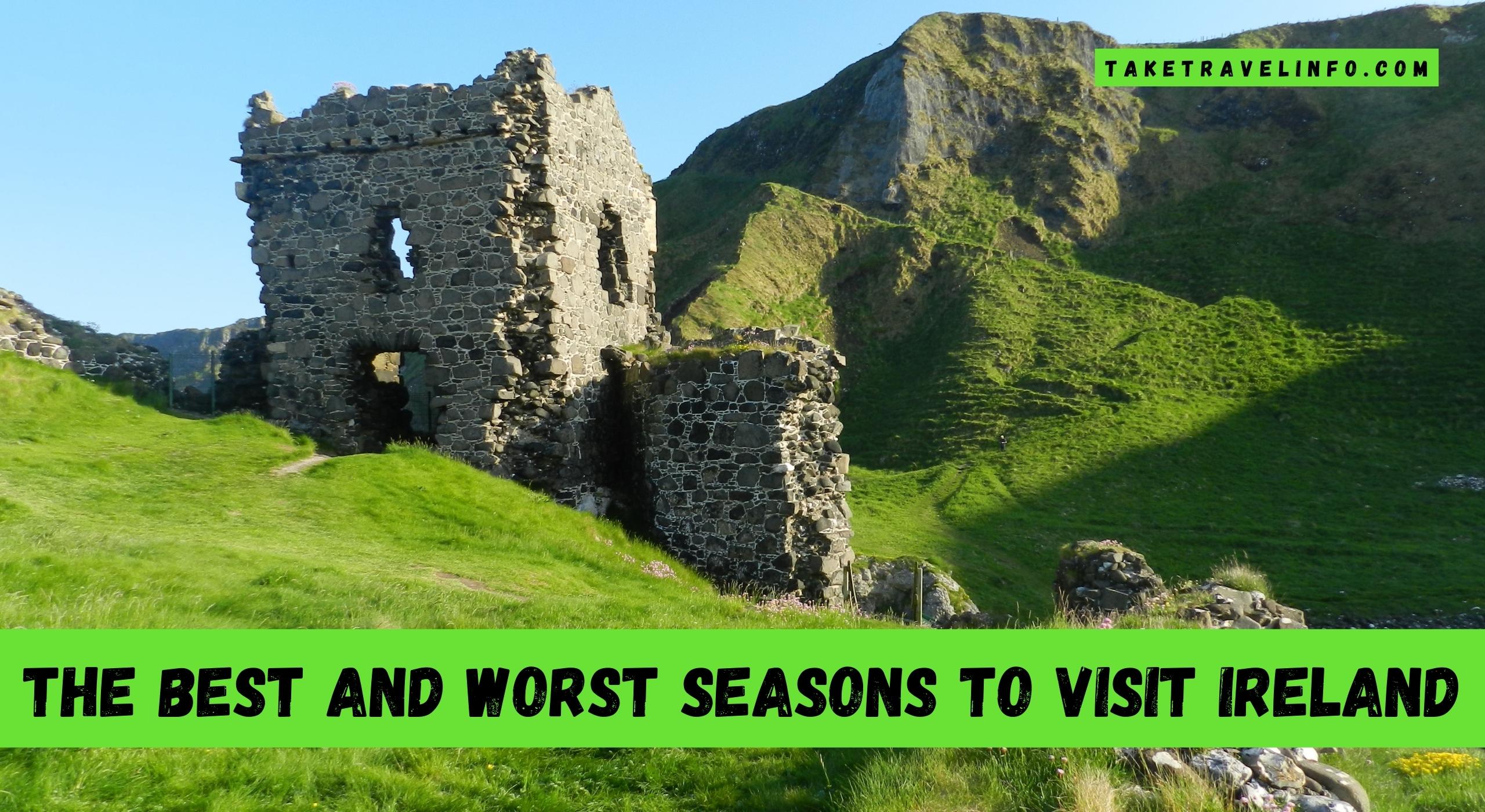The best season to visit Ireland is summer, while the worst season is winter. Ireland is known for its stunning landscapes, vibrant cities, and rich cultural heritage.
Summer, from June to August, offers the warmest temperatures and longer daylight hours, making it an ideal time to explore the country’s picturesque countryside and enjoy outdoor activities. However, winter, from December to February, can be cold, rainy, and dark, with shorter days and limited attractions and outdoor opportunities.
Despite this, visiting Ireland during the winter can have its charm, as the Christmas season brings festive markets and cozy pubs where you can experience the renowned Irish hospitality. Regardless of the season, Ireland’s beauty and charm make it a worthwhile destination year-round.
Best Times to Visit Ireland

The best time to visit Ireland is during the summer months of June to August when the weather is mild and the days are longer. However, the shoulder seasons of spring and autumn offer fewer crowds and lower prices, making them ideal for budget-conscious travelers.
What Month is the Best to Visit Ireland?
There is no definitive answer to this question as it depends on what you are looking for in a trip to Ireland. However, many people believe that the best time to visit Ireland is in the summer months of June, July, and August.
This is when the weather is at its best, with long days and warm temperatures making it ideal for exploring the outdoors. It’s also when school holidays are taking place, so if you have children this may be the most suitable time for your family holiday.

If you’re looking to avoid the crowds, however, then September or October might be better months to travel. The leaves on the trees will be starting to turn yellow and red, making for some beautiful scenery.
And although it can be cold at night time, daytime temperatures are often still pleasant enough to enjoy being out and about. So whatever time of year you choose to visit Ireland, there’s sure to be something special waiting for you.
Is It Better to Visit Ireland in May Or September?

If you’re looking to experience all that Ireland has to offer, then September is the ideal month to visit. The weather is milder than in May, making it more pleasant for outdoor activities and exploring. And because school is back in session, there are fewer tourists around, so you’ll have a more authentic experience.
That said, Ireland is beautiful any time of year, so if your schedule doesn’t allow for a September trip, don’t hesitate to visit in May – you’ll just need to pack a jacket!
Best Time For Outdoor Activities
Mild temperatures and fewer crowds make spring an ideal time to visit Ireland for outdoor activities. The weather is pleasant, allowing you to enjoy hiking and cycling without extreme heat or cold. With the absence of summer tourists, popular outdoor destinations are less crowded, giving you a chance to fully immerse yourself in nature.
During summer in Ireland, you can take advantage of long daylight hours and warm temperatures. This season is perfect for engaging in outdoor festivals and indulging in beach activities. From lively music festivals to sandy shores, summer offers a vibrant atmosphere for outdoor enthusiasts.
When autumn arrives, Ireland is adorned with beautiful foliage and experiences mild weather. This is an opportune time to explore the countryside and take part in activities such as golfing. The autumn colors create a picturesque backdrop, enhancing your outdoor experience.
Best Time For Sightseeing And Cultural Events
During the winter months, Ireland boasts a cozy atmosphere and festive celebrations. It is an ideal time to visit for those interested in sightseeing historical sites and museums. With fewer tourists around, you can fully immerse yourself in the rich history and cultural heritage of the country. The chilly weather adds to the charm, as you explore ancient castles and learn about Ireland’s fascinating past. Don’t miss the opportunity to enjoy cozy evenings in traditional pubs, sipping hot drinks by the fireplace. Winter is truly a magical time to experience Ireland’s cultural events and immerse yourself in the history of this beautiful country.
In spring, Ireland comes alive with blooming flowers and vibrant landscapes. This is an excellent time to explore the numerous castles and gardens that dot the country. Witness the beauty of nature awakening from its winter slumber as you stroll through picturesque gardens and parks. The mild weather allows for pleasant outdoor activities and scenic walks along the stunning coastline. Spring in Ireland offers a unique opportunity to capture beautiful photographs of the countryside in full bloom. Soak in the natural beauty and take in the sights and sounds of a country bursting with life.
Worst Time to Go to Ireland
The worst time to visit Ireland is during the winter months. The weather is cold and wet, and the days are shorter. There are also fewer tourist attractions open during this time of year.
If you must travel to Ireland during the winter, be sure to pack warm clothing and plan your itinerary carefully.
Worst Time For Weather And Crowds
When it comes to visiting Ireland, the worst time for weather and crowds can be during the winter months from November to February, when the weather can be cold, wet, and unpredictable, and attractions can be crowded with tourists. It is best to plan a visit during the summer months from June to August when the weather is warmer and more pleasant, and the crowds tend to be smaller.
The worst time to visit Ireland in terms of weather and crowds is during the winter months, from December to February. During this time, Ireland experiences cold and rainy weather, making it less enjoyable for outdoor activities. However, the advantage of visiting during this season is that tourist attractions are less crowded, allowing you to explore and enjoy them without long queues or overcrowding. On the other hand, the summer months, from June to August, are the high tourist season in Ireland, which means that popular destinations can be quite crowded. Although you can experience occasional rain showers during this time, the pleasant temperatures make it a popular time to visit. Autumn, from September to November, brings increased rainfall and unpredictable weather. However, it is also considered a peak season for tourists, with higher prices for accommodation and attractions. Overall, it is important to consider both the weather and the level of crowds when planning a trip to Ireland.
Seasons in Ireland: Temperature and Climate by Month
Frequently Asked Questions On The Best And Worst Seasons To Visit Ireland
What Is The Best Season To Visit Ireland?
The best season to visit Ireland is during the summer months of June, July, and August. This is when the weather is warmest and most pleasant, with longer days and plenty of sunshine. It’s also the time for festivals, outdoor activities, and exploring the beautiful countryside.
What Is The Worst Season To Visit Ireland?
The worst season to visit Ireland is during the winter months of December, January, and February. The weather during this time can be cold, wet, and unpredictable, with shorter daylight hours. Many attractions and amenities may also be closed or have limited hours, making it less ideal for tourism.
What Is The Weather Like In Ireland?
The weather in Ireland is generally mild and changeable throughout the year. It’s known for its frequent rain showers, so it’s always a good idea to pack waterproof clothing. Winters are typically mild but wet, while summers are cool and pleasant. The weather can vary greatly from day to day, so it’s best to be prepared for all types of conditions.
Can I Visit Ireland During The Off-season?
Yes, you can visit Ireland during the off-season, which is typically considered to be the months of October through April. While the weather may not be as favorable, there are still many attractions and activities available. Additionally, you may find better deals on accommodations and experience fewer crowds, allowing for a more immersive and authentic experience.
Conclusion
To summarize, the best time to visit Ireland is during the spring and fall seasons, which offer pleasant weather, fewer crowds, and vibrant landscapes. Summer brings longer days, but it can get crowded and expensive. Winter offers lower prices, but the weather can be unpredictable.
Ultimately, the choice of the best time to visit Ireland depends on your preferences and priorities. Plan accordingly and make the most of your Irish adventure!

